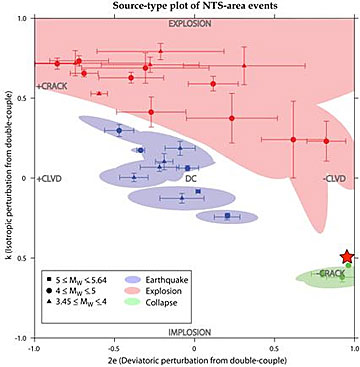UC Berkeley Press Release
Seismologists confirm Utah mine collapse probably caused temblor
BERKELEY – A 3.9 magnitude temblor recorded at the time of a mine collapse in southern Utah on Monday, Aug. 6, was not from an earthquake, but more likely the result of the collapse itself, according to an analysis by University of California, Berkeley, seismologists.
The study by UC Berkeley graduate student Sean Ford and seismologist Douglas Dreger, associate professor of earth and planetary science, complements and confirms the conclusions of University of Utah seismologists, despite claims by the mine owner that a tectonic earthquake triggered the collapse.
 UC Berkeley researchers have categorized earthquakes (blue), underground explosions (pink) and crack collapses (green) according to volume change and other parameters. The Utah temblor of Aug. 6 (red star) falls within the area of an underground cavity collapse, showing that it was not an earthquake. (Graphic by Doug Dreger and Sean Ford/UC Berkeley) |
There is no evidence of both an earthquake and a collapse - just the collapse, Dreger said, and the shaking that was detected bears the signature of a collapse, not a tectonic earthquake.
Rescuers are now drilling toward six coal miners trapped by the collapse, in hopes that they are still alive.
Ford, Dreger and their colleagues, all affiliated with the Berkeley Seismological Laboratory, published their report on the Web on Aug. 8.
Dreger and Ford are involved in a Department of Energy project to detect and characterize different types of seismic events, and have established criteria that distinguish underground explosions and crack collapses from tectonic earthquakes.
After the mine collapse, University of Utah seismologists performed a standard analysis of the seismic data, basically finding that all seismic monitors surrounding the mine recorded initial downward movement, whereas a tectonic earthquake would typically produce both up and down motion, depending on the distance of the seismometer from the event. They concluded that the mine collapse probably caused the shaking.
On Tuesday, Ford and Dreger ran their own analysis of data from seismometers surrounding the mine. They also saw the initial P waves moving downward, but in addition looked at slower S waves and surface waves generated by the event. Performing a more complex analysis of these seismic waves, and allowing for a change in volume underground, they determined that the data fit exactly what would be expected from an underground cavity collapse.
"Using a completely different model and different data, we confirmed what the Utah scientists found," Dreger said. "Together, I'd say these are pretty convincing."
Though Dreger could not pinpoint the exact depth of the event, evidence shows it was shallow, on the order of one kilometer deep, whereas earthquakes typically are centered between 5 and 15 kilometers below the surface. The event also produced mostly low-frequency waves, whereas earthquakes produce low and high-frequency waves.
While the Utah scientists estimated a Richter magnitude of 3.9, Dreger and Ford estimate a moment magnitude of 4.2. These results are generally consistent with one another, Dreger said.
The researchers used data from the National Science Foundation's EarthScope network, which covers about 20 percent of the United States. Coauthors on their paper are UC Berkeley seismologists Robert Uhrhammer and Peggy Hellweg.

